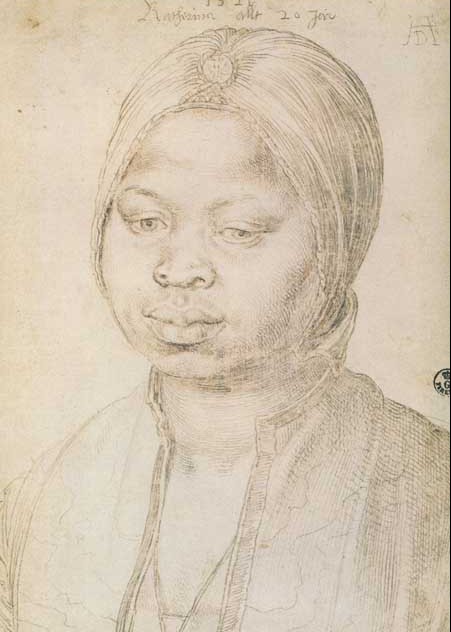
Although little is known about the Moorish woman Albrecht Duerer depicts in his portrait of “Katharina,” the piece nonetheless provides additional evidence that Africans have been in Europe, interacting with European society and culture for centuries — or, in Katharina’s case, since at least the 16th century.
Duerer’s silverpoint portrait of Katharina was created in 1521, and his personal notes indicate that the woman was twenty years old, a Moor, and a servant or slave in the Antwerp household of the Portuguese merchant João Brandão, who lodged Duerer during his visit to Antwerp.
Katharina likely worked in Brandão’s home in some sort of service role. While slavery was illegal in the Low Country, the word ‘slave’ didn’t convey much legal meaning, which leaves Katharina’s status uncertain. This is particularly the case because, in European art, those depicted with sad or somber expressions were often slaves. In comparison with Duerer’s earlier Portrait of an African (1508)), where the bearded subject looks up proudly, Katharina’s gaze is towards the floor, and she does not smile.
Based on Duerer’s description, Katharina , was likely from the northwestern region of Africa, and had likely converted to Christianity from Islam, changing her name to Katharina. Brandão had also likely received her as a part of his dealings (either in a trade or as a gift) in the spice trade with Arab merchants.
Katharina covers her hair, a common practice with European women at the time. Her bonnet is much less grand than the English hoods worn by noblewomen, as to be expected. The ‘V’ shape of her collar and surcoat is also characteristic of the European fashion of the time period, an example of which can be seen in Bernardo Luini’s 1520 Portrait of a Lady.
Katharina’s face is rendered in fine, soft hatching, with special attention paid to the particular shadows of her face. She is not a caricature but rather portrayed delicately and individualistically. The delicate nature of the lines was made possible by the artistic method Duerer used: silverpoint is achieved through sketching with a metal stylus on a surface, in Katharina’s case paper, and leaving behind thin, pale lines. i

In 2012, Black British artist and filmmaker John Akomfrah created an art exhibition featuring an 18-minute short film called Peripeteia, which speculates on the lives of Katharina and the man in Duerer’s companion piece, Portrait of an African. Peripeteia isa Greek word meaning “reversal of circumstances” or “turning point.”
– MJ Montgomery (University of Missouri)